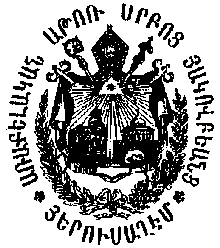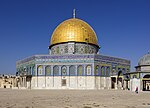
Back البطريركية الأرمنية في القدس Arabic Іерусалімскі патрыярхат Армянскай Апостальскай Царквы Byelorussian Arménský patriarchát jeruzalémský Czech Patriarchat von Jerusalem der Armenischen Apostolischen Kirche German Armena Patriarkejo de Jerusalemo Esperanto Patriarcado armenio de Jerusalén Spanish Patriarcat arménien de Jérusalem French Patriarcat armènien de Jèrusalèm FRP הפטריארכיה הארמנית של ירושלים HE Երուսաղեմի հայոց պատրիարքություն Armenian
| Armenian Patriarchate of Jerusalem | |
|---|---|
 | |
| Classification | Oriental Orthodox |
| Language | Armenian |
| Headquarters | Old City of Jerusalem |
| Territory | Israel, Palestinian Authority, and Jordan |
| Founder | The Apostles Bartholomew and Thaddeus |
| Independence | Apostolic Era |
| Recognition | by Armenian Apostolic Church as their autonomous church |
| Official website | armenian-patriarchate |
| Part of a series on |
| Oriental Orthodoxy |
|---|
 |
| Oriental Orthodox churches |
|
|



The Armenian Patriarchate of Jerusalem, also known as the Armenian Patriarchate of Saint James (Armenian: Առաքելական Աթոռ Սրբոց Յակովբեանց Յերուսաղեմ, Aṙak’yelakan At’voṙ Srboc’ Yakovbeanc’ Yerusaġem, lit. 'Apostolic See of Saint James in Jerusalem'), is located in the Armenian Quarter of Jerusalem. The Armenian Apostolic Church is officially recognised under Israel's confessional system, for the self-regulation of status issues, such as marriage and divorce.
Archbishop Nourhan Manougian, previously the Grand Sacristan and the Patriarchal Vicar, became the 97th Armenian Patriarch of Jerusalem on January 24, 2013. Manougian succeeded Archbishop Torkom Manoogian, who died on October 12, 2012, after serving 22 years in the office. The Patriarch, along with a synod of seven clergymen elected by the St. James Brotherhood, oversees the Patriarchate's operations.
During World War I, survivors of the Armenian genocide received shelter in the Armenian convent in Jerusalem. The Armenian population of Jerusalem reached at that time 25,000 people. But political and economic instability in the region have reduced the Armenian population. Most Armenians in Jerusalem live in and around the Patriarchate at the St. James Monastery, which occupies most of the Armenian Quarter of the Old City. Apart from Jerusalem, there are Armenian communities in Jaffa, Haifa and Nazareth, and in the Palestinian Territories.
The Jerusalem Armenian community uses the Old Julian calendar, unlike the rest of the Armenian Church, which use the Gregorian calendar.[1]
| History of Palestine |
|---|
 |
|
|
- ^ "Church Calendar". Archived from the original on 2017-03-03. Retrieved 2017-03-02.